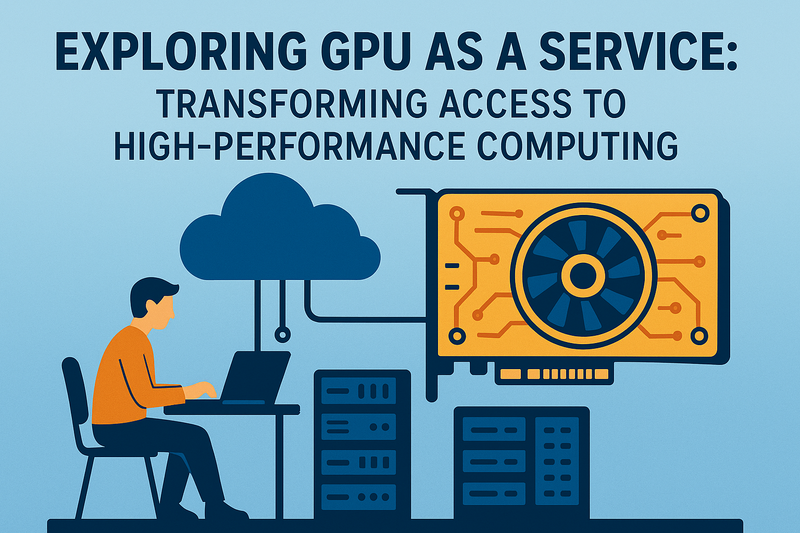In today’s technology-driven world, the demand for high-performance computing has skyrocketed, particularly in fields like artificial intelligence (AI), machine learning (ML), scientific research, and graphics rendering. Central to meeting this demand are Graphics Processing Units (GPUs)—specialized hardware designed for parallel processing tasks.
However, investing in and maintaining GPUs can be costly and complex. This is where GPU as a Service (GPUaaS) steps in—a cloud-based model revolutionizing how organizations rent GPU power and utilize resources efficiently.
What is GPU as a Service?
GPU as a Service (GPUaaS) refers to the on-demand provision of GPU computational power via cloud infrastructure. Instead of purchasing expensive physical GPUs and maintaining them onsite, businesses can rent GPUs online through virtualized environments hosted in data centers operated by third-party providers.
These GPUs can be accessed remotely from anywhere with an internet connection.
This model is largely similar to other “as a Service” frameworks like Infrastructure as a Service (IaaS) but is specifically focused on the specialized computing demands GPUs fulfill.
Key enablers include:
- Virtualization technologies: Dividing physical GPUs into multiple virtual instances.
- Security and isolation: Allowing several users to run workloads simultaneously without interference.
- APIs and management platforms: Enabling users to deploy, monitor, and scale GPU resources dynamically.
Why GPU as a Service Has Emerged
Traditional Central Processing Units (CPUs) are efficient at sequential task processing but fall short in handling highly parallel workloads such as:
- Deep learning
- AI model training
- Complex simulations
- Large-scale data analytics
GPUs, on the other hand, possess thousands of smaller cores optimized for simultaneous operations, making them ideal for such tasks.
But challenges with physical GPU ownership include:
- High upfront costs (e.g., NVIDIA H100 GPUs cost upwards of $30,000 per unit)
- Power, cooling, and maintenance overheads
- Rapid hardware obsolescence due to fast-paced GPU advancements
GPUaaS addresses these issues by offering scalable, flexible, and cost-effective access to powerful GPUs. Businesses simply rent GPU resources on-demand, lowering entry barriers and enabling more agile, innovative workflows.
Key Benefits of GPU as a Service
1. Cost Efficiency
- No need for capital-intensive investments in physical GPUs.
- Pay-as-you-go model (hourly, daily, or monthly billing).
- Reduced risk of underutilization.
- Operational costs (maintenance, power, cooling) offloaded to providers.
2. Scalability and Flexibility
- Scale GPU resources up or down seamlessly based on project needs.
- Suitable for varying workloads, from early testing to full-scale production.
- Avoids paying for idle hardware.
3. Accessibility and Collaboration
- GPU servers can be accessed remotely from anywhere.
- Enhances collaboration among distributed teams.
- Faster project iterations with no dependency on physical location.
4. Simplified Management and Reduced Downtime
- Providers manage backend operations like driver updates and hardware troubleshooting.
- Minimized disruptions with proactive maintenance.
- Integrated monitoring tools provide real-time utilization insights.
5. Immediate Access to Latest Hardware
- Providers upgrade infrastructure with the latest NVIDIA, AMD, and other GPUs.
- Stay competitive without constant reinvestment.
- Access energy-efficient and specialized next-gen GPUs effortlessly.
Use Cases for GPU as a Service
GPUaaS empowers multiple industries and workflows:
- Artificial Intelligence & Machine Learning: Faster model training, hyperparameter tuning, and preprocessing.
- Graphics & Video Rendering: Smooth 3D rendering, animation, and editing.
- Scientific Research & Simulations: Large-scale physics, chemistry, and genomics modeling.
- Gaming & Virtual Reality: Real-time processing for cloud gaming and immersive VR.
- Big Data Analytics: Accelerated handling of massive datasets and complex queries.
How to Choose a GPU as a Service Provider
When selecting a GPUaaS provider, consider:
- Performance & GPU Types: Ensure availability of GPUs like NVIDIA Tesla or AMD Radeon Instinct.
- Pricing Models: Transparent, flexible options aligned with your usage.
- Security & Compliance: Encryption, access control, and certifications for sensitive workloads.
- Support & SLAs: Reliable 24/7 support and guaranteed uptime commitments.
- Ease of Integration: APIs, SDKs, and compatibility with development environments.
Conclusion
GPU as a Service is reshaping how organizations access high-performance computing. It introduces flexibility, scalability, and cost savings while removing the heavy burden of GPU ownership.
By leveraging GPUaaS, companies can:
- Accelerate innovation
- Optimize budgets
- Focus more on breakthroughs rather than infrastructure challenges
In essence, GPUaaS democratizes access to powerful computing resources, making them available to startups, enterprises, and researchers alike—fueling the next generation of AI, data science, and graphics advancements.




Top comments (0)